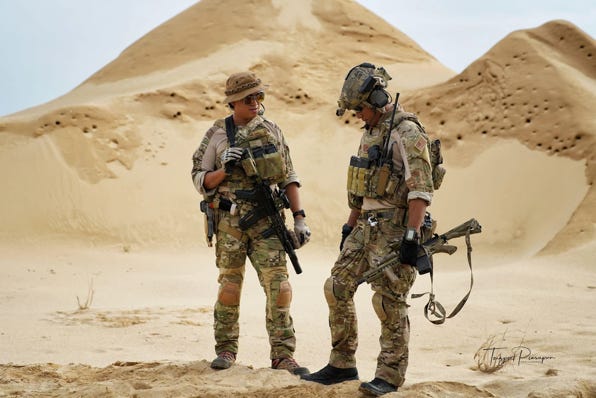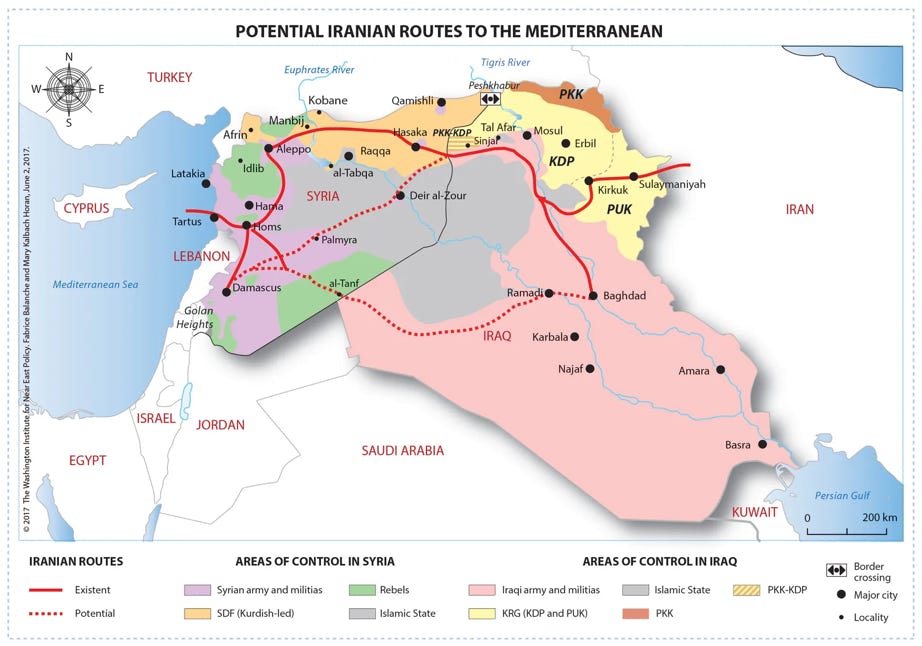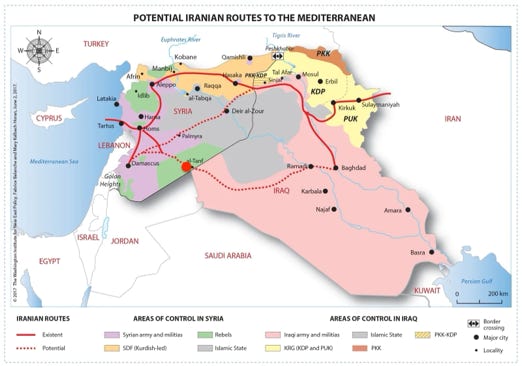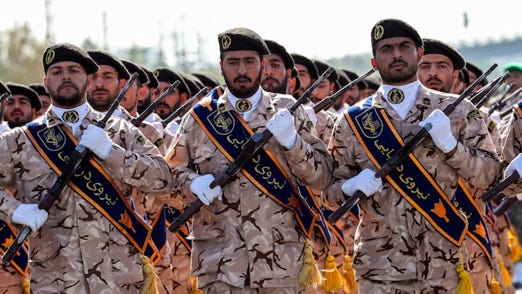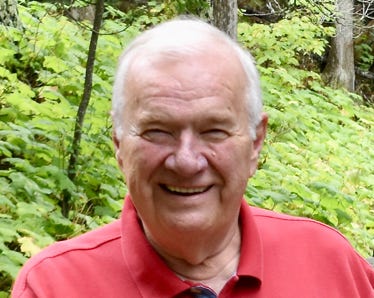DUTY, HONOR, COURAGE, RESILIANCE
Talking Proud: Service & Sacrifice
Syria: A fractured state
Venture into the unfamiliar
Graphic by Fabrice Balanche and Mary Kalbach,
The Washington Institute for Near East Policy
The question of Iran: There is no question
Iranian-supported militias have launched many attacks on US forces in Syria and have supplied its proxies with weapons and fighting forces just as they are doing in Lebanon, Iraq, Yemen, and Gaza. This is no surprise.
The United States Institute of Peace (USIP) counted 75 rocket and drone attacks against bases in Syria used by US forces between October 2023 and February 2024. They have continued beyond that period. No American troops have been killed in Syria through the end of 2024. However, three Army soldiers were killed at the Tower 22 Base in northeast Jordan, about 15 miles south of the US base at al-Tanf. I will discuss both bases in the section about al-Tanf.
Iran’s goal is to achieve hegemony over the Near East region. Thus far, it has concentrated on Shiite regions: Lebanon, Iraq, Bahrain, and even Saudi Arabia, where there is a strong Shiite minority. Itamar Rabinovich has said,
“Distilled to its essence, Tehran’s steadfast support for Assad is not driven by the geopolitical or financial interests of the Iranian nation, nor the religious convictions of the Islamic Republic, but by a visceral and seemingly inextinguishable hatred of the state of Israel.”
In Syria, Iran joined Russia to prop up the Assad regime. Russia has no great love for Assad either, but it does want those air and naval bases in Syria. Russia and Iran inserted military forces into Syria. Iran formed an informal coalition of militias from throughout the Near East to as far as Pakistan and Afghanistan. Their goal was to offset American and Israeli influence and, in the case of Israel, cause its destruction. This coalition is often referred to as the “Axis of Resistence.”
Iran wants to achieve a leadership position in the Near East region by having unbridled access to a “straight and level” land corridor through Iraq and Syria to Lebanon, the Israeli Golan Heights, and the Mediterranean Sea. From the perspective of Iranian leaders, such a corridor would give them a powerful position in the region. Some have called this the quest for “Pax Iranica.”
The map shows Iran’s land route to the Mediterranean Tartus port and Damascus. This is a long and arduous route. Iran would much prefer shooting straight across central Iraq through southern Syria to Damascus, which would provide easy access to Lebanon and Israel’s Golan Heights. Iran and/or its proxies would enter Israel from the east and pass through Lebanon from the north.
No matter what “avenue of resistance” Iran pursues, somewhere in the equation, Israel will be squarely in its sights. Dr. Harold Rhode has said he is sure that Iran played a role in the October 7, 2024 Hamas attacks in Israel that killed 1,300 and captured more than 130. For example, Iran funds Hamas and has helped organize Hamas. Dr. Rhode warns us to keep Israel in mind when thinking about Syria. Furthermore, Syria, for many decades, has been a channel through which Iran can supply Hezbollah in Lebanon.
The US is a critical obstacle to Iran’s quest for its desired corridor. US military forces are in Iraq and Syria. Iran needs to find ways to get the US out of the way.
Iranian-backed militias have attacked US forces in Syria over 125 times through November 2024, and they continue. They have employed all the modern weapons of the day, including drones, rockets, and missiles. Iran has provided these kinds of weapons to its proxy militias not only in Syria but also in Iraq, Lebanon, Yemen, and Gaza.
Pierre Boussel, a researcher specializing in the Arab world, has identified several Iranian objectives. Two of these hit home with me,
- “Create a corridor to the shores of the Mediterranean by eliminating the American presence; and
- “Create the conditions for an encirclement maneuver of the Israeli state if necessary, pre-positioning men and military equipment on the outskirts of the Golan Heights without opening fire on Israeli positions.
Bouseel points to Iran’s choice of irregular warfare to achieve its aims, an “asymmetric approach to the enemy to surprise and destabilize.” Iran’s organization of choice is the Quds Force of the Revolutionary Guards, known as the IGRC.
Iran has a regular, conventional army that does what regular armies do. The IGRC, established in 1979 following the Iranian Revolution and the fall of the Shah of Iran, is separate from the army and was organized to ensure the military did not overthrow the new government. Since then, it has expanded its role to “export the ideology of the regime, whatever that means,” as Boussel has written.
A hallmark of the IGRC in Syria has been setting up proxy militias. Boussel estimates that since becoming involved in the Syrian civil war, the IGRC has established 82 fighting units, with an estimated 70,000 warfighters.
Iran has spent billions of dollars, by one account, $30- $50 billion, since 2012, propping up the Assad regime. But the Iranians are clever, patient people. While they worked to bolster Assad, they created an environment where they could still pursue their goal of projecting military influence beyond their borders even if Assad went down. I have concluded that the fall of Assad in December 2024 jolted the Iranian regime and the Russian leadership. Still, the IGRC anticipated this could happen and remained ready to strike at US forces in Syria nonetheless.
I should note that an estimated 70 percent of Syrians are Sunni Muslims, while over 90 percent of Iran’s people are Shi’a Muslims. The IGRC has managed to organize Iraqi Shi’a jihadists and Shi’a from abroad to fight in Syria. Iraq’s Muslim population is said to be about 55% Shi’a and 40% Sunni. This split has caused political turbulence there for a long time, a split that has created a considerable threat to US military forces in Iraq. The IGRC has exploited the Shi’a-Sunni split in Iraq to its advantage while fighting in Syria and Iraq.
There is cause to believe that Iran is pursuing a divide and control strategy in Syria, a plan that can operate with or without Assad in power.
Briefly, one cannot expect the IGRC to melt away in Syria because of Assad’s removal. Bousell has commented that Iran is in Syria to spread “the Islamic Revolutionary spirit... (and establish) Pax Irania in the Middle East.”
Nicole Grajewski has noted that Iran “operates a constellation of allied regional militias in Syria.” Pierre Boussel has been tracking the Iranian Quds force in Syria for over ten years. He highlights that Iran’s militias consist of Palestinians, Lebanese, Afghan, Pakistani, and Iraqi Shi’a, a network of proxy forces from many countries.
Returning to Dr. Rhode, note this piece of sage advice,
“The Iranians … are excellent long-term planners. Iranians are chess players and rug makers. That means they have patience. They’re not just thinking of the move they’re making now — they’re thinking six moves down the road. What is a rug maker? He’s got patience. You can’t just make a rug — it’s slow and slow, one hooked thread at a time.”
News reports have indicated that Iranian militias have withdrawn. They have not. They continue to attack US forces in Syria. I suspect this issue will be with the region for a long time.
Click to zoom graphic-photo
